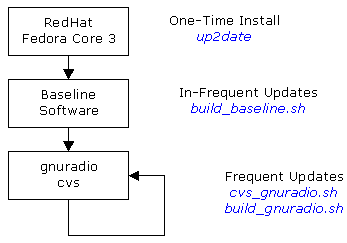|
|
Installation - Overview
Procedure Depreciated - This information is a now out of date. It still includes useful information, so I'll leave it here, but you may want to visit the GNU Radio Build Guide Wiki for an up-to-date install procedure.
Although GNU radio hardware and software are fairly straight forward and
easy to use, getting all the software built and installed is not. As
much as the Linux crowd complains about Microsoft Windoze issues, using
Linux can be difficult. Building software is painful with multiple
versions of the Kernel, package distributions, compiler versions, and C/C++
runtime and support libraries. This procedure was developed for Red
Hat Linux Fedora Core 3 for the Intel Pentium 4 series of processor, but is
applicable to most other versions of Linux.
The following flow chart shows the order of installation.

Build Flow Chart
Build Philosophy
Installation is divided into three sections. The first is the
standard Red hat Fedora Core 3 installed from the CD-ROM or DVD ISO images.
After installation, the entire system was freshen with up2date.
The second is the installation of a number of critical packages required by
GNU radio. Although some of these packages were available as RPMs for
Fedora Core 2 or 3, they were older versions or versions that required
special build options. In this case, we
downloaded and built the application for the source code tree. Finally, the
latest source code tree for GNU radio is downloaded using CVS and again
built from the source code. Although you can use the tar ball images,
cvs offers the latest version of this very rapidly changing system.
The standard installation location for Linux applications is
typically /usr/local. However these scripts and installation procedure are
designed to install in the user's home directory. This allows multiple
users to maintain their own version of GNU radio as well as run as a
standard, non root user. You are running as a regular user, rather
than root, most of the time, right? Another advantage of installing in
a non-standard location is we can easily clean and rebuild the system
without effecting existing RPMs or system files.
Environment Variables
The first step in the build procedure is to set your environment variables
for the variety of packages. You can execute the following directly,
or add it to your .cshrc
file.
Note, these commands are for the /bin/tcsh envioronment and shell,
but can be adapted for your favorite shell.
setenv GR $HOME/gr
set path = ( . $GR/bin $path)
setenv PKG_CONFIG_PATH $GR/lib/pkgconfig/
setenv PYTHONPATH $GR/lib/python2.3/site-packages: \
$GR/lib/python2.3/site-packages/Numeric:/usr/lib/python2.3/site-packages
setenv LD_LIBRARY_PATH $GR/lib
setenv CVS_RSH ssh |
We
are going to build and install the entire GNU radio system and its support
applications in the $HOME/gr
directory.
|





